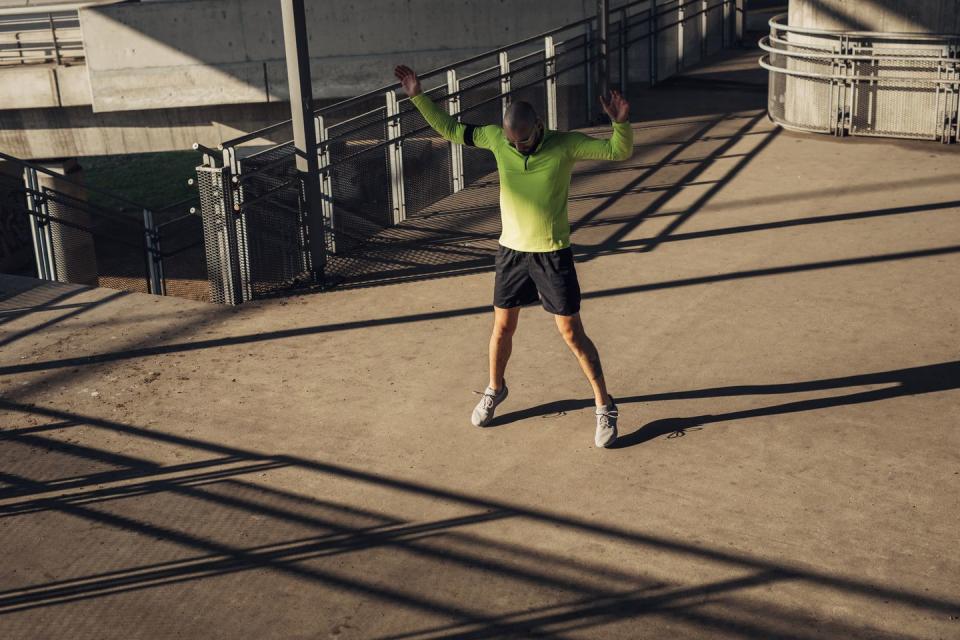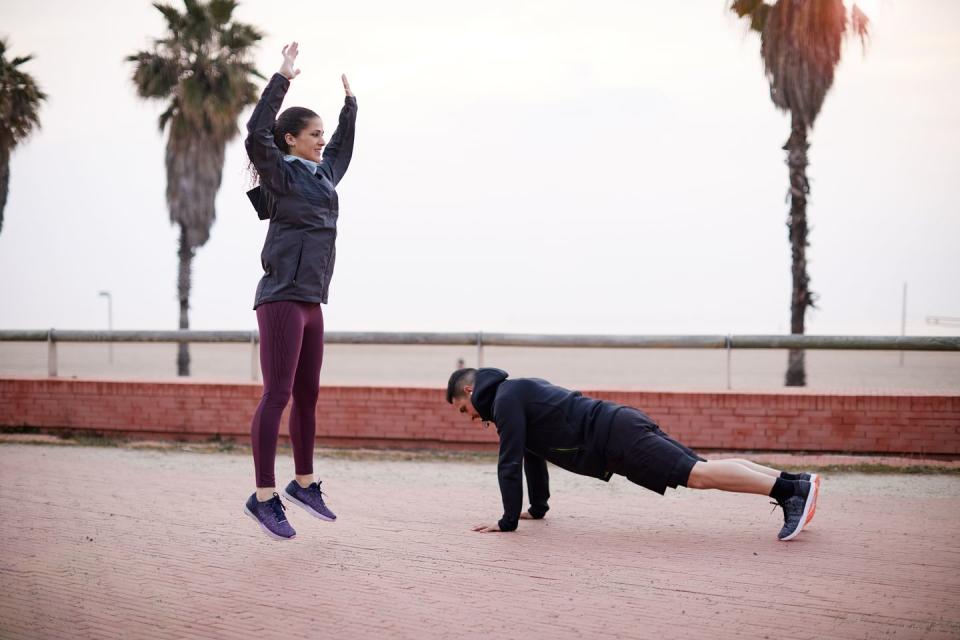Jumping Jacks Aren't Just for Gym Class. Here's Why You Should Add Them to Your Workouts.
"Hearst Magazines and Yahoo may earn commission or revenue on some items through the links below."
YOU MIGHT THINK back to your childhood gym class and remember learning the basics of physical fitness, setting a foundation for the grown-up workouts you continue to do today.
While you likely keep pushups and pullups in your typical rotation, there’s probably an elementary school staple exercise you’ve pushed to the side: jumping jacks. Maybe you feel like you’ve outgrown them, or that they’re not really useful.
“Jumping jacks are one of those things that everyone was told to do in P.E. class. They were seen as this sort of no-athletic objective, basic exercise that was just meant to make you tired. Nobody really knew why they were doing it,” says Alex Viada, C.S.C.S., owner of Complete Human Performance. “So it’s one of those things I think people stop doing because they maybe think it was something given to them by lazy coaches at the beginning of karate class, and they think that’s where the value stops.”
But that’s not quite the case, according to Viada and other coaches. The same move you did to warm up as a 7-year-old can still help you as an athlete, a lifter, and as a guy who wants to maximize his workout’s effectiveness, reduce injury risk, and stay healthy. Yes, really! Here’s how this kids’ exercise can make you a better man.
Benefits of Jumping Jacks
●Jumping jacks can serve as part of an effective dynamic warmup
●Jumping jacks raise your core temperature
●Jumping jacks move your joints through a full range of motion
●Jumping jacks are a simple plyometric exercise
●Jumping jacks are a safe conditioning option for athletes of all sizes
●You can swap jumping jacks for other exercises like burpees
How to Do Jumping Jacks
●Stand in an athletic stance, with your feet together and your hands at your sides. Keep your glutes and abs engaged.
●Jump both feet outward, landing just outside of shoulder-width.
●At the same time, raise your arms over your head, keeping your muscles tensed. You shouldn't have much wasted movement here; keep your arms tight to your body.
●Quickly return to the starting position, then jump right into the next rep.
Jumping Jacks Are a Dynamic Warmup You’ll Actually Do
A dynamic warmup, where you get your joints and heart moving instead of just stretching, will make your workouts better. But no matter how many times we’re presented with amazing pre-workout moves (like these seven that are perfect before any workout), most guys still skip the warmup. These routines might seem boring, they can get complicated, and they might even require learning some new skills—when all we want to do is hit the bench.
The solution: Jumping jacks. “One of the main things you want out of a warmup is to raise the core body temperature, get the heart rate going to prep the body for the workout of the day,” says Ryan Horton, owner and operator of Horton Barbell. “Jumping jacks are an unbelievable tool for that. They incorporate the whole body. It’s elevating the heart rate and core temperature … it’s space-efficient as well. You can warm up right at the rack.”
Jacks have another warmup benefit, Viada says: They move your joints through a wide range of motion.

“The simple act of bringing your shoulders up around the top of your head fulfills a lot of the dynamic warmup and dynamic stretching that people should do more of before training sessions,” he says. “You see a lot of people screwing around with dowels and bands and PVC pipes without realizing that the simple jumping jack, when done correctly, is running them through that same range of motion.”
Using a variation of jumping jacks called “seal jacks” can open up the chest and shoulders for moves like bench presses and flies, Horton says. To do this variation, your feet stay the same as in traditional jumping jacks, but your arms come in front of you and clap—like a seal—on each rep. Try alternating between sets of traditional jumping jacks and seal jacks to get warmed up.
Jumping Jacks Are a Low-Risk Way to Build Power
You’ve probably already heard that muscle mass will fall in your 40s and 50s. But the part that might surprise you is the type of muscle you’ll lose: Research shows that it’s disproportionately from fast-twitch fibers, the muscle fibers that use carbohydrates to fuel quick, powerful contractions.
When we get older and lose fast-twitch fibers, “we lose power at a faster rate than we lose strength. Strength is force development. Power is the rate of force development,” says Nick Tumminello, a personal trainer in Florida and author of books including Strength Training for Fat Loss and Strength Zone Training. Power dictates your ability to generate force quickly—to sprint, jump, perform an Olympic lift, or even catch yourself from falling down. “Just like one of the ways to offset muscle loss through aging is to strength train, the way to offset power loss through aging is to do some things that make you move a little faster. If you're not training for the NFL combine or you're not in college or high school sports anymore, you want to do something that's fairly safe and basic.”
Enter the jumping jack. When you think of plyometrics, you might think of box jumps. But jumping jacks are plyometrics, too. There’s less chance of a fall, smashed shin, or cranky Achilles than with box jumps and, Tumminello says, they can be better for helping you practice moving fast.
“Just because you’re jumping doesn’t mean you’re doing plyometrics. Plyometrics is about reflexes and minimizing ground contact time,” he says. “The longer you’re on the ground, the less ploymetric effect you’re getting. So a jumping jack is actually more plyometric than a box jump, because you’re spending so much less time on the ground [between each rep].”
Jumping Jacks Are a Great Conditioning Option for Bigger Guys
“I work with a lot of larger athletes, like people from strongman backgrounds who want to get into more conditioning. So I do have them do certain conditioning-type complexes, and the standard jumping jack is one I will have them use pretty frequently,” Tumminello continues. “These are big, strong athletes who are capable of doing other forms of cardio, but having them do standard jumping jacks is relatively low mental engagement. They know what to do, and it lets them think about the conditioning and the range of motion.”
Jumping jacks, he says, are largely safe. And because they don’t require much concentration, they’re good for keeping his athletes’ heart rates up between sets of more mechanically and mentally-taxing moves.
“Let’s say you’re doing some high-intensity interval training using kettlebell swings or something like that,” he says. “Putting in a set of 30 seconds of jumping jacks between sets can keep the exercise going, keeps the heart rate going, while giving you some recovery [to do the next set of swings safely.]”
Whether you’re an XXL powerlifter or a slight runner, “a lot of people will be surprised at how hard it is to get to 30 seconds of jumping jacks,” Horton says.
3 Ways to Use Jumping Jacks in Your Training
Use Jumping Jacks as a Warmup
We’ve already covered what makes jumping jacks and seal jacks such great, simple warmup moves. Viada and Horton both suggest jumping right into them, performing 2 to 3 sets of 20 or 30 jacks (or 20 to 30 seconds of continuous reps) to get your heart rate pumping. Tumminello programs jumping jacks for his clients after a pre-workout foam roll and mobility session. And to maximize their effectiveness as a dynamic stretch for the shoulders, he’s picky about execution.
“Really incorporate the arms and do an arm drive. You’re not just flailing your arms up and down,” he says. “Actively lift your arms up and then snap them down. If it’s a seal jack, actively drive your arms back and clap them together. The same thing with your feet—it’s short, quick, tight movements.”
Use Jumping Jacks in a Bodyweight Finisher Circuit
Jumping jacks are a great option for keeping your heart pumping as you work through a bodyweight circuit, Horton says. Since you actually have to jump, they’re hard to cheat, so your heart rate will elevate when you’re mid-jack—making them a great addition to a workout finisher. Try tacking this routine from Horton at the end of your workout.
Perform each move for 20 seconds, then move to the next exercise. Repeat for four rounds.
Exercise 1: Pushups
Exercise 2: Air squats
Exercise 3: Burpees
Exercise 4: Jumping Jacks

Use Jumping Jacks in Place of Burpees
You’re not alone if you don’t like burpees. Viada suggests swapping jumping jacks in for the dreaded burpee if you’re looking for a similar, less-dangerous conditioning option.
“It’s not the exact same kind of challenge, but you’re still getting the same kind of full-body conditioning effect,” he says. If a metabolic conditioning challenge calls for a round of burpees, try 20 to 30 seconds of jumping jacks instead.
Tumminnello suggests using jacks in place of burpees in one of the most popular—and punishing—protocols in the gym: Tabata-style finishers. You could simply do a four-minute set of 20 seconds on, 10 seconds off of hard, fast jumping jacks. Or mix them with a few other moves. Try this tabata-inspired finisher from Tumminello.
Perform each move for 20 seconds, resting 10 seconds before moving to the next exercise. One round should take two minutes. Go for four total rounds.
Exercise 1: Jumping Jacks
Exercise 2: Shadowboxing
Exercise 3: Forearm Plank
Exercise 4: Mountain Climber
You Might Also Like

